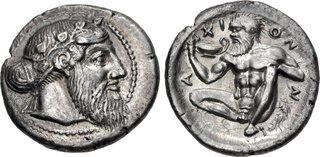| Classical Numismatic Group > Triton XXVII | Auction date: 9 January 2024 |
| Lot number: 54 Price realized: 62,500 USD (Approx. 57,244 EUR) Note: Prices do not include buyer's fees. | Show similar lots on CoinArchives Find similar lots in upcoming auctions on |
| Lot description: SICILY, Naxos. Circa 461-430 BC. AR Drachm (18.5mm, 4.25 g, 5h). Bearded head of Dionysos right, wearing ivy wreath / Silenos, nude and ithyphallic, squatting half-left, holding kylix in right hand and supporting himself with his left, tail behind; N-A-XI-ON around; all within shallow concave circular incuse. Cahn 55 (V41/R46); Campana 8 var. A/a; HGC 2, 990; SNG Lloyd 1151 = Weber 1467 (same dies); SNG Lockett 841 = Pozzi 508 (same dies); Basel 385 (same dies); Gillet 484 = Sartiges 110 (same dies); Jameson 674 (same dies); de Luynes 1063 (same dies); McClean 2467 (same dies); Rizzo pl. XXVIII, 13 (same dies). Lightly toned, underlying luster, a hint of porosity. Good VF. From the Father & Son Collection. Ex Roma XX (29 October 2020), lot 66 (hammer £26,000); Ambrose Collection (Roma VII, 22 March 2014), lot 132 (hammer £32,000). Located on the eastern shore of Sicily in the shadow of Mt. Aitna, Naxos was the oldest of the Greek colonies on the island, founded in 735 BC by colonists from Chalkis in Euboia and Ionia. According to Thucydides (1.100), Naxos established its own colony by founding Leontini in 730 BC, which was soon followed by the foundation of a second colony, Aitne, later known as Katane. Taking advantage of the fertility of the surrounding volcanic soil of Mt. Aitna, Naxos developed an economy of viticulture, and along with Leontini and Katane became very prosperous. This wealth attracted the attention of Syracuse, which subjugated Naxos in 476 BC, removing its citizens along with those of Katane to Leontini. Upon the death of Hieron in 461 BC, the Naxians were reinstated to their original city, and formed a close alliance with Leontini and Katane. During the first Athenian Expedition in 427 BC, Naxos actively provided support to the Athenians, who had sent a large fleet to support the allies against Syracuse. In 409 BC, Naxos sided with Syracuse against the Carthaginian threat to Sicily, but in 403 BC, the tyrant Dionysios of Syracuse turned against the Naxians, destroying the city and selling the women and children into slavery. The present issue is composed of multiple denominations in silver, and is dated by Cahn to the first few decades after the refoundation of the city in 461 BC. Some theorize that it was struck upon the refoundation as a celebratory issue, but one wonders whether the city had the resources for such a coinage so soon. It could also have been struck somewhat later, after the city had prospered from its trade ties to Kamarina and Leontini, and could afford the requisite silver for such a large output. The types found on the drachms are the same as that on the famed tetradrachms (Cahn 54), and the styles of both are so close that it is likely they were engraved by the same hand. The obverse features Dionysos, the god of the vine. The reverse is also an allusion to wine and the Dionysiac cult, featuring the satyr Silenos. Half-man, half-goat followers of Dionysos, these satyrs were often depicted in an ithyphallic state as they pursued the god's female attendants, the mainads. Silenos was the oldest, wisest, and most drunken of the satyrs. According to Euripides' only surviving satyr-play, the Cyclops, Silenos had been forced to attend to Polyphemos, who dwelled in the region of Mt. Aitna, hence providing another reason for Silenos' appearance on this coin of Naxos. Estimate: 20000 USD |  |



